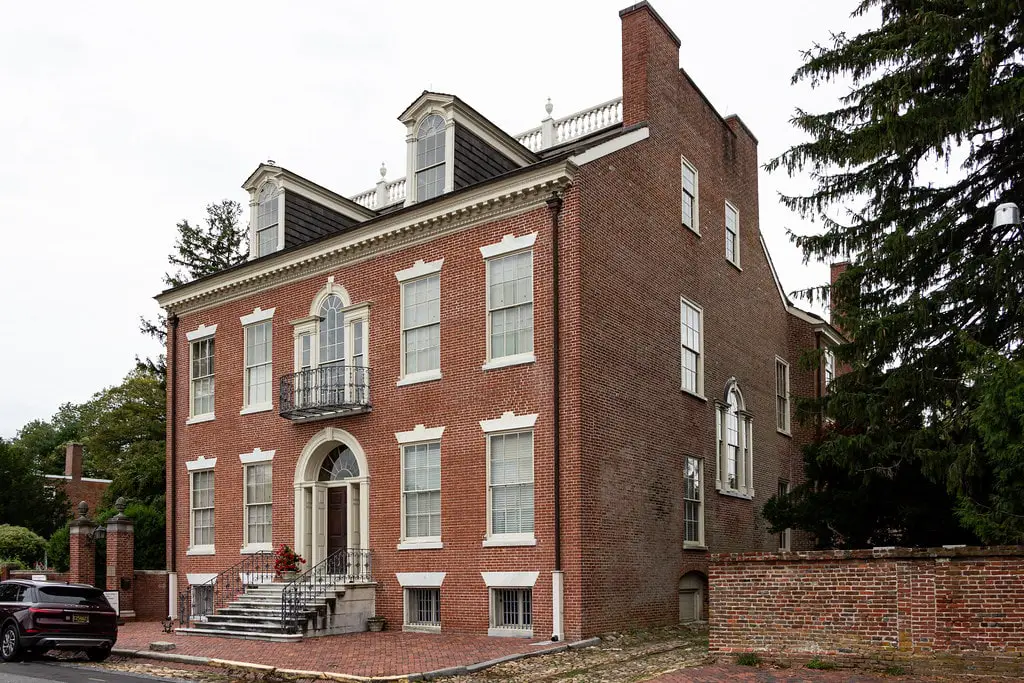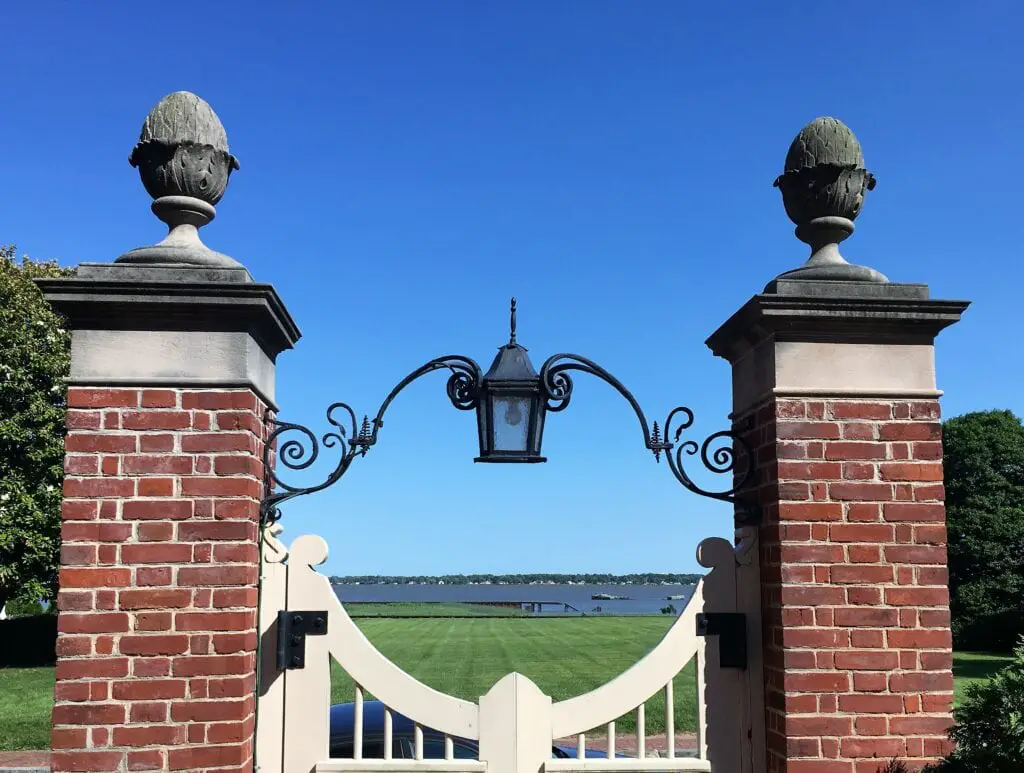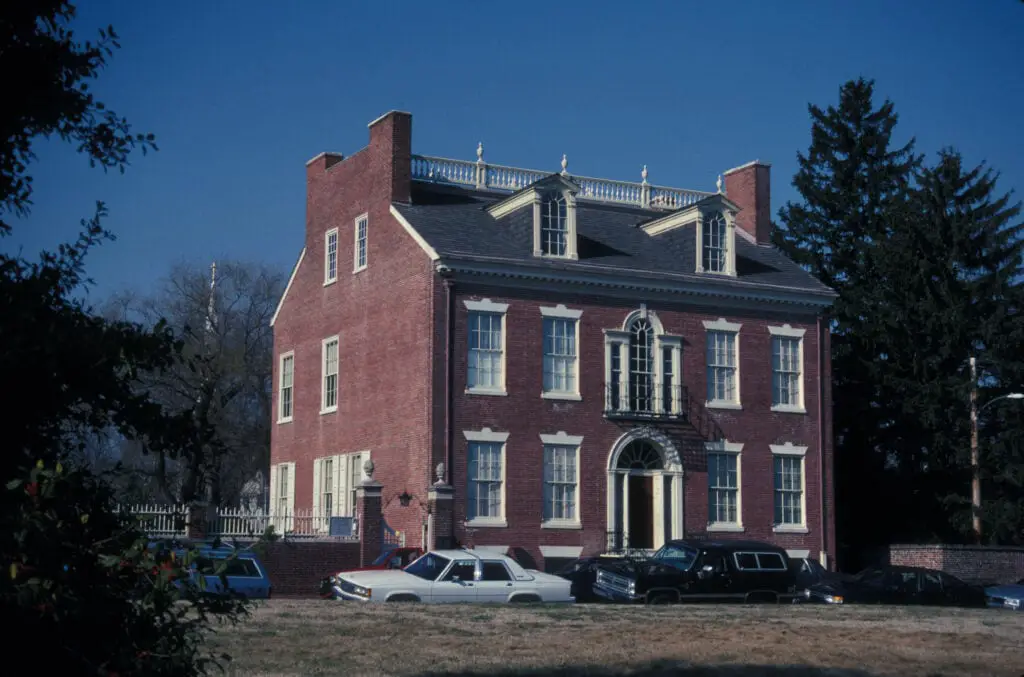New Castle’s Pride: The Historic Read House and Gardens
Nestled in the heart of New Castle, Delaware, the Read House and Gardens is a testament to the rich history and architectural grandeur of the early United States.
This majestic property, located at 42 The Strand, has been a cornerstone of Delaware’s cultural landscape since its construction in 1804.
Today, it is a portal to the past and a vibrant center for community engagement and historical exploration.
The Read House, built for George Read Jr., son of the notable statesman George Read, represents the pinnacle of Federal period architecture in Delaware.
At the time of its completion, it was the largest private residence in the state, boasting over 14,000 square feet of space.
The house’s design was inspired by the Adamesque houses of Philadelphia, showcasing a cutting-edge, refined elegance for its era.
Adjacent to the house, the formal gardens, laid out in the late 1840s by William Couper, add a layer of serene beauty to the property.
These gardens have evolved over the years, maintaining the essence of Couper’s original design while adapting to contemporary horticultural practices.
The combination of the house and gardens creates a picturesque setting that attracts visitors from all over, making it one of the things to do in New Castle, Delaware.
As of 2024, the Read House and Gardens continues to captivate visitors with its historical authenticity and modern relevance blend.
Operated by the Delaware Historical Society, the property is not just a museum but a dynamic space where history is preserved and made.
Through its various programs, tours, and events, the Read House and Gardens remains integral to New Castle’s cultural fabric, inviting people of all ages to step back and experience the richness of Delaware’s past.
Architectural Marvel of the Federal Period
The Federal Style Embodied
The Read House, constructed between 1797 and 1804, is a paramount example of Federal architecture, which flourished in the American post-revolutionary period.
This architectural form, known for its symmetry, balance, and adherence to classical ideals, was a departure from the earlier, more ornate Georgian style.
The house’s design, influenced by the Adamesque houses in Philadelphia, showcases the elegance and refinement that characterized the Federal style.
Its distinct features include a side gable roof, a truncated peak with a low balustrade, and sash windows with rectangular openings with stone sills and splayed stone lintels.

Construction and Design Features
The Read House’s construction process was significant in the late 18th century. The 2.5-story brick building, resting on a robust stone foundation, was a marvel of its time.
It features four chimneys integrated into each end wall and a curtain wall between them. The front facade, five bays wide, is centered around a main entrance adorned with sidelight windows, pilasters, and a large half-round transom window.
Above this entrance, the second story boasts a Palladian window, adding to the building’s grandeur. The house’s total area exceeds 14,000 square feet, making it the largest private residence in Delaware at the time.
Influence and Significance
The Read House’s architectural significance extends beyond its physical features. As a leading example of Federal architecture in Delaware, it reflects the period’s cultural and aesthetic values.
The house’s design, borrowing elements from prominent Philadelphia residences, signifies the transfer and adaptation of architectural trends across regions.
Its inclusion in the National Register of Historic Places and designation as a National Historic Landmark in 2016 further attest to its historical and architectural importance.
The Legacy of George Read Jr.
A Prominent Figure’s Residence
George Read Jr., the original owner of the Read House, was a figure of considerable stature in Delaware’s early history.
As the son of George Read, a signer of the Declaration of Independence, Read Jr. inherited a legacy of political and social influence.
He was a successful lawyer and businessman whose wealth and status were reflected in the grandeur of his residence.
The house, therefore, is not just a structure but a symbol of Read Jr.’s prominence in Delaware society.
Contributions to Delaware’s History
Beyond his professional success, George Read Jr.’s contributions to Delaware’s history are multifaceted.
His involvement in legal and business affairs during a formative period in the state’s history positioned him as a key figure in the shaping of Delaware’s early economic and political landscape.
The Read House, as his residence, became a focal point of social and political activity, hosting gatherings that included influential figures of the time.

The House as a Historical Artifact
The Read House, as the home of George Read Jr., serves as a tangible connection to an influential period in Delaware’s history.
It is a testament to the life and times of one of Delaware’s leading figures, offering insights into the lifestyle, tastes, and social customs of the late 18th and early 19th centuries.
The house’s preservation allows visitors to step into a bygone era, providing a unique window into the past and the legacy of George Read Jr. in Delaware’s rich historical tapestry.
The Evolution of the Gardens
The Late 19th Century Transformation
Initially laid out in the late 1840s, the Read House’s gardens are as integral to the property’s charm as the house itself.
William Couper, the third owner of the Read House, was instrumental in establishing the formal gardens.
After a devastating fire in 1824, which consumed several adjacent properties, including the original house of George Read I, Couper utilized the newly opened space to create a garden that would complement the grandeur of the Read House.
His vision brought about a transformation, turning the area into a landscape of beauty and tranquility.
Design and Features
As William Couper envisioned, the gardens’ basic layout remains largely intact. The design includes brick walkways meandering between the beds, a hallmark of garden design from that era.
Two pavilions, added by the Delaware Historical Society, are based on similar structures in late 19th-century photographs, offering a nod to the garden’s historical authenticity.
While the types of plantings may have evolved, the essence of Couper’s design endures, providing a glimpse into the horticultural style of the mid-1800s.
A Living Historical Document
Today, the gardens serve as a space of aesthetic pleasure and a living historical document. They reflect the changes in landscape design over the centuries, adapting to modern horticultural practices while preserving historical integrity.
The gardens continue to be a significant attraction for visitors, offering a serene escape and a vivid representation of 19th-century garden design.

A Journey Through Ownership
The House’s Stewards
After George Read Jr. died in 1836, the Read House saw notable owners, each contributing to its history. John M. Clayton, another prominent Delaware statesman, briefly rented the house.
The next owner, William Couper, established the gardens and maintained the house’s status as a symbol of affluence and elegance in New Castle.
The Lairds’ Era of Preservation
In the early 20th century, the house was acquired by Philip and Lydia Laird, who were deeply involved in New Castle’s historic preservation movement.
Their tenure marked a significant period in the house’s history as they undertook efforts to maintain its historic integrity.
Lydia Laird’s legacy of the property to the Delaware Historical Society in 1975 was a pivotal moment, ensuring the preservation and public accessibility of this historic landmark.
Under the Delaware Historical Society
Since its acquisition by the Delaware Historical Society, the Read House has been meticulously cared for, focusing on preserving its historical and architectural significance.
The Society’s stewardship has ensured that the house and gardens remain a vibrant part of Delaware’s cultural heritage, serving as a museum and educational resource.
Their efforts have kept the legacy of the Read House alive, allowing it to continue to tell its story to new generations.
Restoration and Preservation Efforts
Historical Integrity and Restoration Projects
Since its inception, the Read House has undergone various restoration projects, each to preserve its historical integrity.
One of the most significant undertakings was the comprehensive restoration initiated by the Delaware Historical Society.
This project focused on the house’s interior and exterior, ensuring that the architectural details and structural elements remained true to the original design.
The restoration efforts extended to the gardens, where historical landscaping techniques were employed to maintain the authenticity of William Couper’s original design.

The Role of the Delaware Historical Society
The Delaware Historical Society has played a crucial role in preserving the Read House. Their commitment to maintaining the property’s historical accuracy is evident in their meticulous approach to restoration.
The Society has also been instrumental in researching and documenting the house’s history, providing valuable insights into its past.
Their work ensures that the Read House remains a physical structure and a repository of cultural and historical knowledge.
Recent Initiatives and Achievements
In recent years, the Delaware Historical Society has launched initiatives to enhance the sustainability and accessibility of the Read House.
These include environmentally friendly practices in garden maintenance and installing energy-efficient systems within the house.
These efforts demonstrate a commitment to preserving the property for future generations while adapting to contemporary conservation and sustainability standards.
Read House and Gardens Today
A Cultural and Educational Hub
As of 2024, the Read House and Gardens continues to thrive as a cultural and educational hub. It offers a range of programs, including guided tours, educational workshops, and community events.
These activities highlight the house’s historical significance and engage the public in understanding and appreciating Delaware’s rich heritage.
Engaging the Community
The Read House plays a vital role in the community, offering a unique space for learning and engagement.
It hosts school tours, group visits, and special events, making history accessible and relevant to people of all ages.
The house and gardens are a backdrop for various cultural events, drawing visitors from across the region and beyond.
Looking to the Future
The future of the Read House and Gardens looks promising, with ongoing plans to enhance visitor experiences and educational offerings.
The Delaware Historical Society continues exploring new ways to bring the property’s history to life, ensuring it remains a vibrant and significant part of New Castle’s cultural landscape.
The Read House, with its rich history and continued relevance, stands as a testament to the enduring value of preserving the past.

Conclusion
Summarizing the Historical Journey
The Read House and Gardens in New Castle, Delaware, encapsulates more than two centuries of American history, architecture, and culture.
From its construction in the late 18th century to its current status as a cherished historical landmark, the property has witnessed and adapted to numerous changes while retaining its intrinsic historical value.
The journey of the Read House, through various owners and periods, reflects the broader narrative of American history, particularly in the context of Delaware’s development.
The House’s Role in Delaware’s Heritage
The Read House and Gardens symbolize the region’s architectural, social, and cultural evolution. It serves as a tangible link to the past, offering insights into the lives of those who shaped the history of Delaware and the United States.
The preservation efforts by the Delaware Historical Society and other property stewards have ensured that this historical gem continues to educate and inspire.
